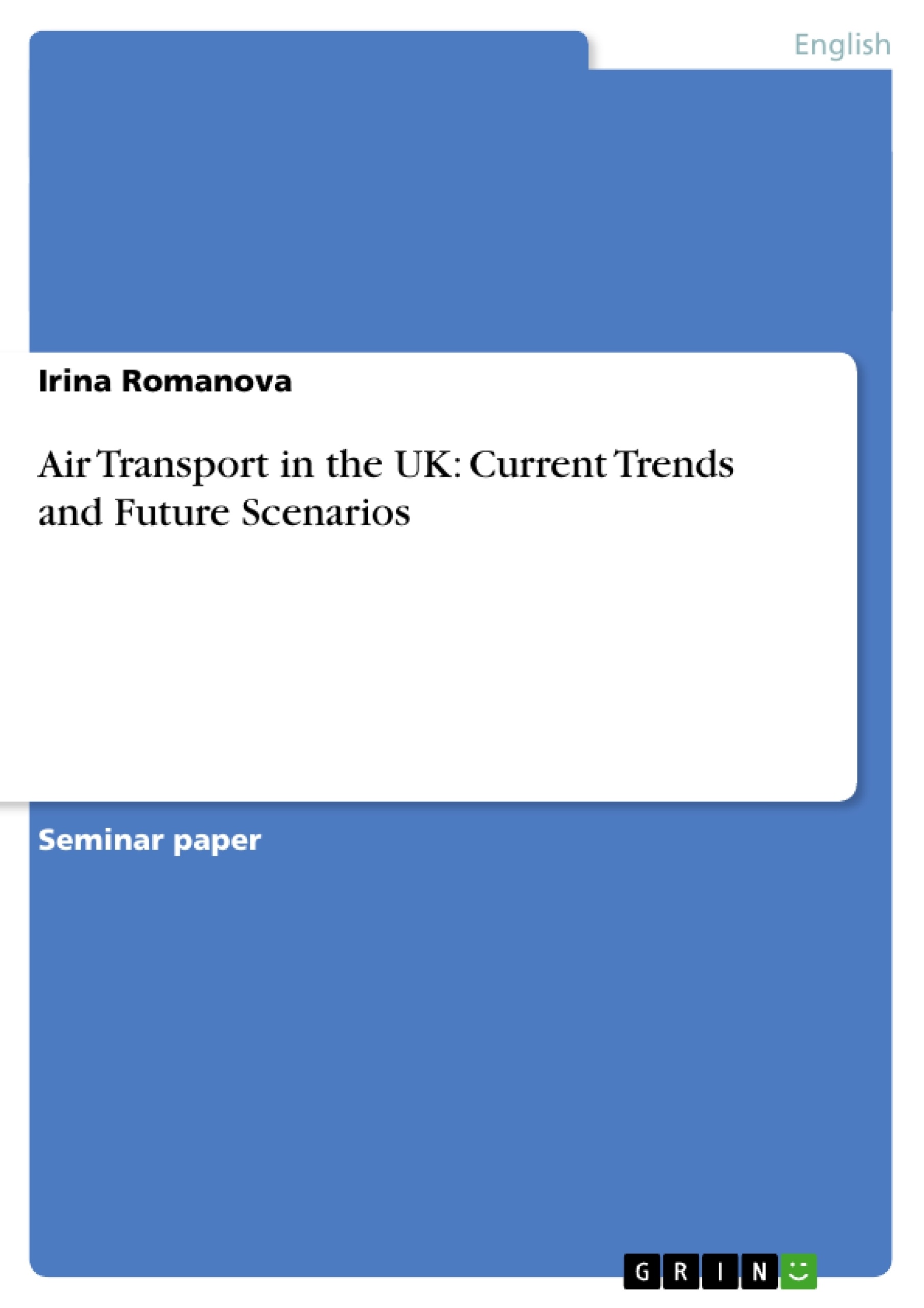Excerpt
Structure
1. Air transport key facts
a) contribution of aviation to the UK economy
b) current trends in air traffic
2. Organization of the air transport industry
a) airlines
b) commercial operators of airports
c) other players
3. Air traffic growth versus airports capacity
a) need for additional capacity
b) where to build
4. The impact of aviation on the environment
a) global warming and climate change
b) threat to human health
c) diminishing countryside and traffic congestion
5. Future of air transport in the UK
a) future demand
b) internalisation of “externalities”
1. Air transport key facts
1.a. Contribution of aviation to the UK economy
The aviation industry has brought many benefits to society in both economic and social terms. The relative affordability and speed of air transport today have made international travel accessible to many people and it has become an integral part of their lifestyle. In economic terms, aviation contributes to a country´s growth in two ways. First, the growth of the aviation industry itself generates employment, production, exports, value added, investment and contributions to the Exchequer. Secondly, air transport facilitates trade in goods, industrial developments and economic services.
Contribution to GDP: Aviation accounts for 1.2% of national GDP. By including retailing and catering at airports it makes up 1.4% of GDP. The official Oxford Economic Forecasting study[1] estimated that over the last 10 years aviation growth had increased output in the UK economy by £550 million per year.[2]
Exports: One third of the UK exports now go by air. Exports of services, which depend on the ability to travel by air, make up a further 8% of the national income.[3]
Tourism: Today, UK residents make around 60 million visits overseas each year, compared to just 13 million in 1978. Around 80 % of these are made by air due to the fact that they have little alternative to air travel for long-haul, and many short-haul, destinations. This outbound tourism contributes significantly to the economy through revenue earned, for instance, by tour operators. Another source of earnings is foreign visitors, two thirds of whom (ca. 55 million out of 80 million) come by air. In-bound tourism accounted for an estimated 4.4 % of GDP in 2002, and more than 2 million direct jobs.[4]
Attractiveness for setting up businesses: The strength of Britain´s air transport links is one of the key criteria for international businesses when making decisions whether to allocate their activities in the UK. In a tough competitive environment, UK airport operators and UK-based carriers of all types are leaders in their fields, whose success brings significant economic benefits to the country. An illustration of this is the fact that one fifth of all international air passengers in the world are on flights to or from a UK airport.
Many airports increasingly act as a focal point for “clusters” of business development. By offering the potential for the rapid delivery of products by air freight and convenient access to international markets through the availability of flights for business travel, they can attract inward investment to a region. Not only do they attract businesses and generate employment, but also open up wider markets. They can provide an important impetus to regeneration and a focus for new commercial and industrial development. And they are increasingly important transport hubs, especially for the logistics industry.
Jobs: The aviation industry itself directly supports around 200,000 jobs, and indirectly up to three times as many. These are employees who work for airlines (in 2002: around 87,500 employees)[5], those working in supporting facilities, tour operators and others.
Regional economics: Air services are important for the economic vitality of Scotland, Wales and Northern Ireland, and the English regions. They offer rapid access to other parts of the country, and essential connections to a range of European and global markets. For some communities, like those in the Scottish Highlands and Islands or Isles of Scilly, air services are of the highest importance.
Some airport clusters, such as those in the West of Scotland or at Bournemouth airport, relate directly to the provision of aviation-related services, such as aircraft maintenance and aeronautical components. At present, however, the majority of indirect employment associated with the supply of goods and services to airports and the airlines which operate from them is located in the South East of England. Building local supply chains and capacity for the aviation industry, including the promotion of Centres of Excellence for aircraft maintenance, could bring important benefits to the economies of regions, as well as assisting the airports and airlines that serve them.
1.b. Current trends in air traffic
The main tendency in the aviation industry over the last 30 years has been strong growth and it has the highest growth rates of all modes of transport. There has been a five-fold increase in air travel within the aforementioned period (see chart below)[6].
Abbildung in dieser Leseprobe nicht enthalten
Half the population of the UK now flies at least once a year. And freight traffic at UK airports has doubled since 1990. Such factors as technological advances, cost efficiencies and strengthened competition have provided the way to this growth and brought air travel within the reach of many more people. In an era of increasing globalisation, foreign travel – whether for pleasure or on business – is now a common experience.
[...]
[1] The report was produced in 1999 for a consortium of UK’s major airlines and operators and the Department the Environment, Transport and the Regions.
[2] Whitelegg, J., Whilliams, N., „The Plane Truth: Aviation and the Environment“ 2000
www. aef.org.uk/PDFs/5389SainsburyDoc.pdf
[3] Department for Transport, „The Future of air Transport“ 2003, www.dft.gov.uk/aviation/whitepaper
[4] Department for Transport...
[5] Department for Transport...
[6] Department for Transport...
- Quote paper
- Irina Romanova (Author), 2004, Air Transport in the UK: Current Trends and Future Scenarios, Munich, GRIN Verlag, https://www.grin.com/document/36306
Publish now - it's free






















Comments